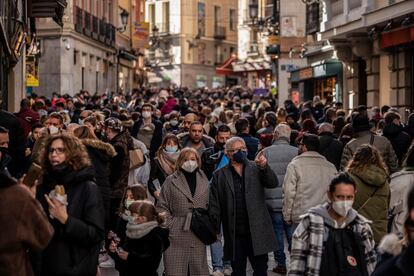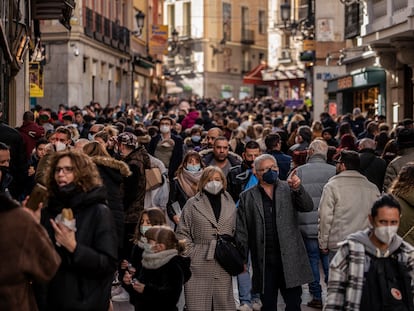In Spain, Covid hospital admissions jump 32% in a week, as incidence hits 290 cases per 100,000
At least 11 infections of the omicron variant have been confirmed in the country, two of which have no connection to travel to South Africa


Covid-19 is once again gaining ground in Spain. All of the indicators are rising, according to the latest reports from the central Health Ministry. Infections, hospitalizations and the number of patients being treated in the country’s intensive care units (ICUs) are on the up. In the midst of a long weekend – December 6 and 8 are national holidays – and with the Christmas holiday season just around the corner, the 14-day cumulative incidence stands at 290 cases per 100,000 inhabitants, according to the data published on Tuesday.
With nearly 80% of the country’s population fully vaccinated against Covid-19, the pressure on hospitals is lower than during previous waves of the pandemic. But the rise in cases is still having an effect on the healthcare system. Admissions grew nearly 32% in the last week, and there are now more than 5,000 Covid-19 patients in hospital – 948 of them in a critical condition. The Health Ministry reported 43,808 new cases since Friday, as no data is supplied over the weekend or on national holidays. A total of 78 fatalities were added to the official death toll, which now stands at 88,237. Since the beginning of the pandemic, 5,246,766 coronavirus infections have been detected.
In barely a week, the incidence has risen by 40% and experts believe that the epidemiological curve is going to continue to rise. In winter, people spend more time indoors, often in badly ventilated spaces, and this favors the spread of the virus. What’s more, with the holiday celebrations coming up, there will be more socializing and mobility, other factors that will see the coronavirus circulate.
This will all be happening in a context of few restrictions, with only the use of masks indoors still obligatory, a recommendation to observe social distancing, and so-called “Covid passports” required for those wishing to enter establishments such as bars and nightclubs in certain regions of Spain.
At the end of November, the coronavirus R number in Spain – i.e. the number of other people a positive case would infect – was 1.14. That’s to say, for every 100 infections, another 114 people would catch the coronavirus. This is slightly below the level registered on November 16, when the R number was 1.3, but it is still above the level of 1 that the health authorities consider the limit in terms of keeping the virus under control. Spain is yet to see the peak of this new wave, the sixth since the pandemic hit the country.
In terms of hospitals, the situation is still under control, although it is getting more complicated in some regions. The pressure on the healthcare system is lower than it was at this time last year – the incidence then was 240 cases per 100,000 inhabitants, but there were more than 13,000 people hospitalized, and 4,400 ICU patients – but there are five territories right now with high ICU occupation, with more than 15% of beds taken by Covid-19 patients.

In this context of a rising epidemiological curve, the threat of the new omicron variant is of concern. Discovered in South Africa several weeks ago, this strain is feared by experts to be more infectious and there are suggestions that it could partially evade the protection offered by the current Covid-19 vaccines due to its many mutations. According to the latest Health Ministry report, Spain has used sequencing techniques to identify 11 cases of omicron, two of those with no connection to travel from South Africa. This figure is likely to rise, with the Canary Islands reporting its first case on Tuesday, and the Balearic Islands another two.
For now, however, there is no solid evidence about the true threat that omicron presents, but the early data is not promising. The United Kingdom government announced on Tuesday that the early signs show that omicron is more transmissible than the delta strain, which is currently dominant. The UK’s health minister, Sajid Javid, warned on Monday that there is already community transmission of the variant in the country.
What’s more, the director of the European Center for Disease Prevention and Control (ECDC), Andrea Ammon, stated on Tuesday during a meeting with European health ministers in Brussels that preliminary data from South Africa and the UK also suggest that the strain is more transmissible, and that if this is the case, omicron would be responsible for 50% of the infections in the coming months in the European Union.
A total of 634 omicron cases have already been detected in 23 countries from the EU and the European Economic Area (EEA). “For now, there are no serious cases nor deaths among those detected, but it is still early to decide on the level of danger,” Ammon said. The head of the ECDC called for non-pharmaceutical measures to be introduced, as well as booster shots of Covid-19 vaccines, “starting with vulnerable adults aged over 40.” She also called for action to combat the rising number of infections in Europe, with some members states such as Belgium and the Netherlands already seeing 14-day incidence rates in excess of 2,000 cases per 100,000 inhabitants.
Meanwhile, in Spain, the regions – which are in charge of their Covid-19 restrictions, healthcare systems and vaccination drives – are relying on vaccinations and the implementation of Covid-19 passports to keep the curve under control.
On Tuesday, Spain’s public health commission gave the green light to vaccinations for five- to 12-year-olds, which should begin from December 15. The under-12s, which are the only group in Spain yet to be vaccinated, are currently the age group with the highest incidence rate of the coronavirus, at 498 cases per 100,000 inhabitants over the previous 14 days.
The vaccination of children will overlap with the ongoing process of offering booster shots to priority groups as established in Spain’s strategy. Currently, the over-60s, those with suppressed immune systems, seniors in care homes, healthcare workers and those who were given the single-dose Janssen vaccine are eligible for another dose.
In total, 5.8 million of these booster shots have already been administered in Spain: 71% of over-70s have received them, as well as 38% of those who were originally given the Janssen medication.
Tu suscripción se está usando en otro dispositivo
¿Quieres añadir otro usuario a tu suscripción?
Si continúas leyendo en este dispositivo, no se podrá leer en el otro.
FlechaTu suscripción se está usando en otro dispositivo y solo puedes acceder a EL PAÍS desde un dispositivo a la vez.
Si quieres compartir tu cuenta, cambia tu suscripción a la modalidad Premium, así podrás añadir otro usuario. Cada uno accederá con su propia cuenta de email, lo que os permitirá personalizar vuestra experiencia en EL PAÍS.
¿Tienes una suscripción de empresa? Accede aquí para contratar más cuentas.
En el caso de no saber quién está usando tu cuenta, te recomendamos cambiar tu contraseña aquí.
Si decides continuar compartiendo tu cuenta, este mensaje se mostrará en tu dispositivo y en el de la otra persona que está usando tu cuenta de forma indefinida, afectando a tu experiencia de lectura. Puedes consultar aquí los términos y condiciones de la suscripción digital.
More information
Últimas noticias
Most viewed
- Sinaloa Cartel war is taking its toll on Los Chapitos
- Oona Chaplin: ‘I told James Cameron that I was living in a treehouse and starting a permaculture project with a friend’
- Reinhard Genzel, Nobel laureate in physics: ‘One-minute videos will never give you the truth’
- Why the price of coffee has skyrocketed: from Brazilian plantations to specialty coffee houses
- Silver prices are going crazy: This is what’s fueling the rally










































